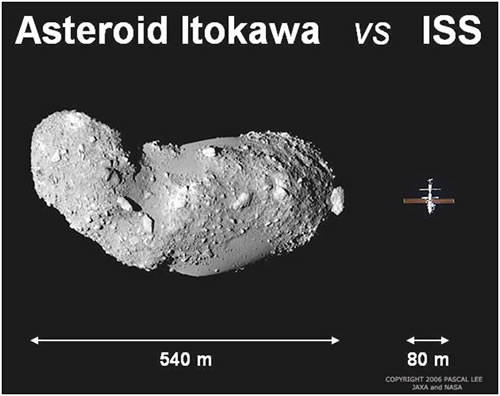The Hayabusa Mission
Hayabusa was a joint ISAS (now JAXA)-NASA-Australia mission to return regolith from the near-Earth asteroid Itokawa. The Hayabusa spacecraft was launched on 9 May 2003 on an M-V rocket from the Uchinoura Space Center. Following launch, the spacecraft’s name was changed from the original MUSES-C to Hayabusa, the Japanese word for falcon, an allusion to the hovering manner in which the spacecraft would collect regolith samples. The spacecraft arrived at Itokawa in September 2005 and spent the next several months surveying and sampling the asteroid.
Asteroid Itokawa, with the International Space Station (at right) for scale.
Hayabusa surveyed the asteroid surface from a distance of about 20 km, the “gate position”. After this the spacecraft moved closer to the surface (the “home position”), and then approached the asteroid for a series of soft landings and for the collection of samples at a safe site. Autonomous optical navigation was employed extensively during this period because the long communication delay prohibited Earth-based real-time control. The spacecraft’s collection mechanism failed to operate properly, but both of the spacecraft’s tough-and-go maneuvers resulted in thousands of regolith grains being collected.

The Hayabusa sample return capsule being recovered from the Woomera Prohibited Area, on June 13, 2010.
After a few months in proximity to the asteroid, the spacecraft was scheduled to fire its engines to begin its cruise back to Earth. This maneuver was delayed due to problems with attitude control and the thrusters of the craft. Once it was on its return trajectory, the re-entry capsule was released from the main spacecraft three hours before reentry, and the capsule coasted on a ballistic trajectory, re-entering the Earth’s atmosphere alongside the main spacecraft at in the early morning of June 13, 2010. It is estimated that the capsule experienced peak deceleration of about 25 G before landing via parachute in the Woomera Prohibited Area, South Australia.

